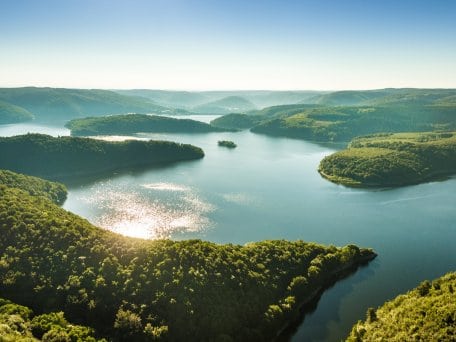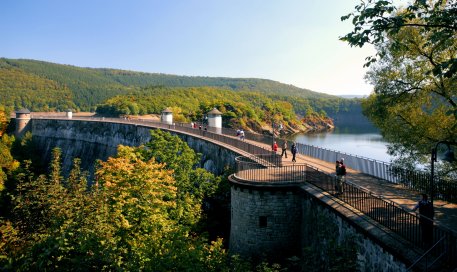The Urft reservoir provides a vital habitat for animals
The Urfttalsperre (also known as the Urft dam or Urft reservoir) is a particularly special reservoir in the Eifel National Park. It is part of the large chain of reservoirs along the Rur and its tributaries, which has shaped the landscape and also includes the Obersee and the Rur dam, which lie downstream of the Urft dam.
The Urft reservoir holds approx. 45 million cubic metres of water and was established at the start of the 20th century to prevent flooding, provide water to industry along the Rur river and to procure energy. The heavy flow of water from the nearby streams collects during the winter and early spring and is returned over the course of the summer. The water is piped via a 2.7 kilometre tunnel through the Kermeter uplands into the hydroelectric power station in Heimbach, where it is used to generate electricity. The Obersee, which lies below the Urft dam, is used to provide drinking water. Water from the Urft reservoir is fed into the Obersee in the case of particularly heavy precipitation or when the water level of the latter reservoir is too low.
The Urft reservoir provides a vital habitat for animals
Several large types of birds breed here. During the winter, you can observe waterbirds resting and wintering on the surface of the water. The reservoirs are an ideal source of nutrition for birds of prey and bats, while their banks provide food for game.
The Urftseerandweg (Urft reservoir round walk) – county road no. 7 (K 7) – on the northern shore allows cyclists and pedestrians to experience the full length of the Urft dam. In order to prevent the animals from being scared away, the National Park does not permit bathing or boating on the Urft reservoir and the southern shore is not accessible by path. Like the Obersee and the Rur dam, the Urft dam and reservoir are the property of the Eifel-Rur Water Board (WVER). The water level is regulated in line with the water board’s technical responsibilities and the equipment is regularly serviced and maintained.
The continued use of the water for industrial purposes within the National Park, which is an otherwise protected area, is contractually governed by an agreement between the State of North Rhine-Westphalia and the WVER. As a result, it is a designated management zone within the National Park.


